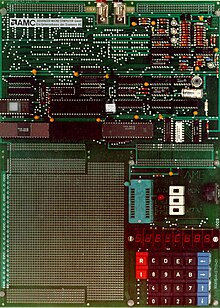ECB85
The ECB85 experimental computer was a single-board computer manufactured by Advanced Micro Computer GmbH (a Siemens AG company) in Ottobrunn and intended for learning purposes.
History and Development
The ECB85 was developed in 1978/79 by Advanced Micro Computer (AMC) GmbH in Ottobrunn near Munich, where the ECB85 was also manufactured. It was presented for the first time in 1979 by Siemens AG , which took over sales, at an electronics trade fair in Paris. The experimental computer should promote the component business with processors, memory and input / output modules and enable potential customers to familiarize themselves with microcomputer technology. The ECB85 was also used in the company's own vocational school for electrical and data technology assistant professions. Production of the ECB85 ended in 1984.
hardware
The core of the ECB85 was the 8085 A microprocessor , together with the 8155 multi-function module and the 8279 keyboard and display module . Arranged around these components were a hexadecimal keyboard, a seven-segment LED display, an EPROM burner with DC / DC converter , a cassette interface and a grid for experimental set-ups . The ECB85 was particularly popular as an EPROM programming device.
Further key technical data:
- CPU: 8085A, 6.144 MHz
- RAM: 1.25 KB
- EPROM: 2 KB monitor program, 1 or 2 KB EPROM burner (2758, 2716) with special base
- Ports: 22 inputs / outputs with grid for experimental setups
- Timer: 1
- Keyboard: 22 digits (16 hexadecimal keys, 4 arrow keys, reset key, interrupt key)
- Display: 8-digit seven-segment display
- Interface: cassette interface
- Operating voltage: 5 V DC (DC-DC converter for 25 V EPROM burning voltage available)
- Dimensions: PCB 234 × 320 mm (4 euro cards)
software
The ECB85 got its functionality from the monitor program ECB85-MON1 with a size of 2 KB, which was stored as an integral part of the experiment computer in a 2716 EPROM. This program used the hexadecimal keyboard and the 8-digit seven-segment display for communication with the user. The program divided the display into three fields: a command field, an address field and a data field. A cursor flashed at the point in the display where an input was expected (the lowest horizontal segment of the display). The cursor could be moved to the left or right with the arrow keys . The other arrow keys were used to switch addresses forwards and forwards within a command sequence.
12 commands were implemented in the monitor program:
- Read out and write to memory
- Fill memory area with constant
- Move memory contents or transfer (burn) to EPROM
- Move memory contents (programs) with address conversion
- Port output
- Port entry
- Read out and write registers
- Start program (without breakpoint)
- Start program with breakpoint
- Execute the program in single step
- Write information on the cassette
- Read information from cassette
Programs could only be entered in hexadecimal as machine code .
Individual evidence
- Siemens: ECB85 experiment computer, instruction manual . Siemens AG, Munich 1981, order no. L8385-A-S710-1.
- Ingrid Beck: Controls with the microcomputer . Verlagsgesellschaft Schulfernsehen, Cologne 1985, ISBN 3-8025-1229-4 .
